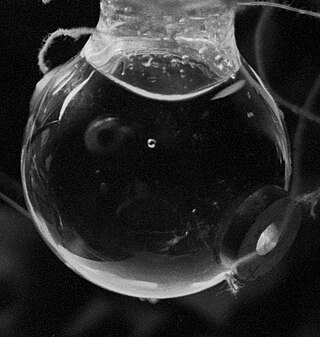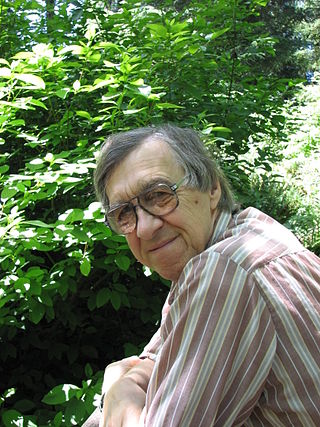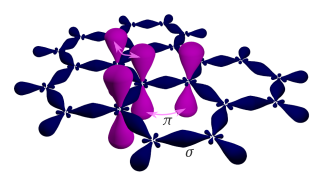Harold E. Puthoff | |
|---|---|
| Born | 1936 (age 87–88) Chicago, Illinois, U.S. |
| Education | |
| Occupation(s) | Engineer and parapsychologist |
| Known for | Paranormal research |
Harold Edward "Hal" Puthoff (born 1936) is an American electrical engineer and parapsychologist. [1]
Harold E. Puthoff | |
|---|---|
| Born | 1936 (age 87–88) Chicago, Illinois, U.S. |
| Education | |
| Occupation(s) | Engineer and parapsychologist |
| Known for | Paranormal research |
Harold Edward "Hal" Puthoff (born 1936) is an American electrical engineer and parapsychologist. [1]
Puthoff was born in Chicago, Illinois. He received a BA and an MSc in electrical engineering from the University of Florida. [2] In 1967, Puthoff earned a Ph.D. in electrical engineering from Stanford University with a thesis, "The stimulated Raman effect and its application as a tunable laser". [3] [4] [5] Puthoff then worked on tunable lasers and electron beam devices and co-authored (with R. Pantell) Fundamentals of Quantum Electronics (Wiley, 1969). Puthoff also published papers on polarizable vacuum (PV) and stochastic electrodynamics.
He took an interest in the Church of Scientology in the late 1960s and reached what was then the top OT VII level by 1971. [5] Puthoff wrote up his "wins" for a Scientology publication, claiming to have achieved "remote viewing" abilities. [6] In 1974, Puthoff also wrote a piece for Scientology's Celebrity magazine, stating that Scientology had given him "a feeling of absolute fearlessness". [7] Puthoff severed all connection with Scientology in the late 1970s. [8]
In 1985, Puthoff founded The Institute for Advanced Studies at Austin (IASA), later incorporated under EarthTech International, Inc., in 1991, which pursues energy generation and propulsion research. [9]
Puthoff and EarthTech were granted a US Patent [10] in 1998, with claims that information could be transmitted through a distance using a modulated potential with no electric or magnetic field components. While "the invention does appear to rest on solid, albeit somewhat obscure, physics principles", the case is used for educational purposes in patent law where "the examiner failed to make a prima facie case for inoperability or lack of enablement". [11] According to the Wisconsin Law School case study, "The lesson of the Puthoff patent is that in a world where both types of patents are more and more common, even a competent examiner may fail to distinguish innovation from pseudoscience."
In the 2010s, he co-founded the UFO-dedicated company To the Stars with Tom DeLonge.
In the 1970s and 1980s, Puthoff directed a program at the Stanford Research Institute (SRI) to investigate paranormal abilities, collaborating with Russell Targ in a study of the purported psychic abilities of Uri Geller, Ingo Swann, Pat Price, Joseph McMoneagle and others, as part of what they called the Stargate Project. Both Geller and Swann convinced Puthoff and Targ that they possessed psychic powers, [12] [13] though Geller employed sleight of hand tricks. [14]
Puthoff and Targ studied Uri Geller at SRI, declaring that Geller had psychic powers, though there were flaws with the controls in the experiments, and Geller used sleight of hand on many other occasions. [15] [16] According to Terence Hines:
Geller turned out to be nothing more than a magician using sleight of hand and considerable personal charm to fool his admirers. The tests at SRI turned out to have been run under conditions that can best be described as chaotic. Few limits were placed on Geller's behavior, and he was more or less in control of the procedures used to test him. Further, the results of the tests were incorrectly reported in Targ and Puthoff's Nature paper. [17]
Psychologists David Marks and Richard Kammann attempted to replicate Puthoff and Targ's remote viewing experiments. In a series of thirty-five studies, they could not replicate the results. While investigating the procedure of the original experiments, Marks and Kammann discovered that the notes given to the judges in Puthoff and Targ's experiments contained clues as to which order they were carried out. Examples included referring to yesterday's two targets or the inclusion of the date of the session written at the top of the page. They concluded that these clues were the reason for the experiment's high hit rates. [18] [19] Terence Hines has written:
Examination of the few actual transcripts published by Targ and Puthoff show that just such clues were present. To find out if the unpublished transcripts contained cues, Marks and Kammann wrote to Targ and Puthoff requesting copies. It is almost unheard of for a scientist to refuse to provide his data for independent examination when asked, but Targ and Puthoff consistently refused to allow Marks and Kammann to see copies of the transcripts. Marks and Kammann were, however, able to obtain copies of the transcripts from the judge who used them. The transcripts were found to contain a wealth of cues. [20]
Marks noted that when the cues were eliminated the results fell to a chance level. [21] James Randi noted that controlled tests by several other researchers, eliminating several sources of cueing and extraneous evidence present in the original tests, produced negative results. Students also solved Puthoff and Targ's locations from the clues that had inadvertently been included in the transcripts. [22] Marks and Kamman concluded: "Until remote viewing can be confirmed in conditions which prevent sensory cueing the conclusions of Targ and Puthoff remain an unsubstantiated hypothesis." [23] According to Martin Gardner, Puthoff (and Targ) "imagined they could do research in parapsychology but instead dealt with 'psychics' who were cleverer than they were". [24]
In the late 1980s and 1990s, Puthoff co-authored papers [25] [26] using the model of stochastic electrodynamics that leads to a model of inertia as an electromagnetic drag force on accelerating particles produced by interaction with the zero-point field. [27] This concept built on Andrei Sakharov's proposal in 1968 that the gravitational constant was a consequence of zero-point fluctuations in the vacuum. [28] : 162 Steve Carlip disputed one of Puthoff's 1989 papers for containing a serious computational error which makes the effect negligible; [29] Puthoff responded that a different parameter value in the model would restore its usefulness. [28] The 1994 paper was the subject of a news article in Science . [30] Subsequent analysis by Yefim S. Levin raising numerous questions concerning the mathematical correctness of the formula and the use of non-relativistic treatments of magnetic effects, concluding that model does not show inertia as a result of zero-point-field effects. [31] The cosmological implications of a different 1989 paper by Puthoff [32] on the origin electromagnetic zero point energy was examined by Paul S. Wesson [33] Among numerous difficulties, general relativity requires that such energy not gravitate, so it cannot be similar to electromagnetic radiation.
Building on earlier theoretical work by Robert L. Forward leveraging the Casimir force to extract electrical energy, [34] Daniel Cole and Puthoff analyzed the thermodynamics of a simple hypothetical Casimir force device. [35] The hypothetical devices discussed in these articles are capacitors, multiple layers of charged conductors sufficiently close for the short-range Casimir force to compress the structure. This works against the mutual repulsion of the conductor's electrical energy stores; external electricity would be needed to recharge the device. Other authors have studied mechanical and thermal devices based on Casimir forces. [36]
Massimo Pigliucci called Puthoff's hopes to extract zero-point energy as running contrary to the laws of physics: "a proposition... that violates basic principles of thermodynamics and that is considered pseudoscience by credentialed physicists." [37]

In quantum field theory, the Casimir effect is a physical force acting on the macroscopic boundaries of a confined space which arises from the quantum fluctuations of a field. It is named after the Dutch physicist Hendrik Casimir, who predicted the effect for electromagnetic systems in 1948.

Clairvoyance is the claimed ability to acquire information that would be considered impossible to get through scientifically proven sensations, thus classified as extrasensory perception, or "sixth sense". Any person who is claimed to have such ability is said to be a clairvoyant.
A wormhole is a hypothetical structure connecting disparate points in spacetime, and is based on a special solution of the Einstein field equations.

Sonoluminescence is the emission of light from imploding bubbles in a liquid when excited by sound.

Zero-point energy (ZPE) is the lowest possible energy that a quantum mechanical system may have. Unlike in classical mechanics, quantum systems constantly fluctuate in their lowest energy state as described by the Heisenberg uncertainty principle. Therefore, even at absolute zero, atoms and molecules retain some vibrational motion. Apart from atoms and molecules, the empty space of the vacuum also has these properties. According to quantum field theory, the universe can be thought of not as isolated particles but continuous fluctuating fields: matter fields, whose quanta are fermions, and force fields, whose quanta are bosons. All these fields have zero-point energy. These fluctuating zero-point fields lead to a kind of reintroduction of an aether in physics since some systems can detect the existence of this energy. However, this aether cannot be thought of as a physical medium if it is to be Lorentz invariant such that there is no contradiction with Einstein's theory of special relativity.

Robert Lull Forward was an American physicist and science fiction writer. His literary work was noted for its scientific credibility and use of ideas developed from his career as an aerospace engineer. He also made important contributions to gravitational wave detection research.

Remote viewing (RV) is the practice of seeking impressions about a distant or unseen subject, purportedly sensing with the mind. A remote viewer is expected to give information about an object, event, person, or location hidden from physical view and separated at some distance. Physicists Russell Targ and Harold Puthoff, parapsychology researchers at Stanford Research Institute (SRI), are generally credited with coining the term "remote viewing" to distinguish it from the closely related concept of clairvoyance. According to Targ, the term was first suggested by Ingo Swann in December 1971 during an experiment at the American Society for Psychical Research in New York City.

In quantum field theory, the quantum vacuum state is the quantum state with the lowest possible energy. Generally, it contains no physical particles. The term zero-point field is sometimes used as a synonym for the vacuum state of a quantized field which is completely individual.

A magnon is a quasiparticle, a collective excitation of the spin structure of an electron in a crystal lattice. In the equivalent wave picture of quantum mechanics, a magnon can be viewed as a quantized spin wave. Magnons carry a fixed amount of energy and lattice momentum, and are spin-1, indicating they obey boson behavior.

In quantum field theory, a false vacuum is a hypothetical vacuum that is relatively stable, but not in the most stable state possible. In this condition it is called metastable. It may last for a very long time in this state, but could eventually decay to the more stable one, an event known as false vacuum decay. The most common suggestion of how such a decay might happen in our universe is called bubble nucleation – if a small region of the universe by chance reached a more stable vacuum, this "bubble" would spread.
Stochastic electrodynamics (SED) is extends classical electrodynamics (CED) of theoretical physics by adding the hypothesis of a classical Lorentz invariant radiation field having statistical properties similar to that of the electromagnetic zero-point field (ZPF) of quantum electrodynamics (QED).

Charles T. Tart is an American psychologist and parapsychologist known for his psychological work on the nature of consciousness, as one of the founders of the field of transpersonal psychology, and for his research in parapsychology.
Ingo Douglas Swann was an American psychic, artist, and writer known for being the co-creator, along with Russell Targ and Harold E. Puthoff, of remote viewing, and specifically the Stargate Project.

Russell Targ is an American physicist, parapsychologist, and author who is best known for his work on remote viewing.
Bernard Michael Haisch is a German-born American astrophysicist who has done research in solar-stellar astrophysics and stochastic electrodynamics. He has developed with Alfonso Rueda a speculative theory that the non-zero lowest energy state of the vacuum, as predicted by quantum mechanics, might provide a physical explanation for the origin of inertia, and might someday be used for spacecraft propulsion. Haisch has advocated the serious scientific study of phenomena outside the traditional scope of science and is known for his interest in the UFO phenomenon as well as a variety of other unorthodox topics.
Sensory leakage is a term used to refer to information that transferred to a person by conventional means during an experiment into ESP.
PVLAS aims to carry out a test of quantum electrodynamics and possibly detect dark matter at the Department of Physics and National Institute of Nuclear Physics in Ferrara, Italy. It searches for vacuum polarization causing nonlinear optical behavior in magnetic fields. Experiments began in 2001 at the INFN Laboratory in Legnaro and continue today with new equipment.

In cosmology, the cosmological constant problem or vacuum catastrophe is the substantial disagreement between the observed values of vacuum energy density and the much larger theoretical value of zero-point energy suggested by quantum field theory.
Stanford Research Institute in Menlo Park, California carried out research on various phenomena characterized by the term parapsychology from 1972 until 1991. Early studies indicating that phenomena such as remote viewing and psychokinesis could be scientifically studied were published in such mainstream journals as Proceedings of the IEEE and Nature. This attracted the sponsorship of such groups as NASA and The Central Intelligence Agency.

Graphene is a semimetal whose conduction and valence bands meet at the Dirac points, which are six locations in momentum space, the vertices of its hexagonal Brillouin zone, divided into two non-equivalent sets of three points. The two sets are labeled K and K'. The sets give graphene a valley degeneracy of gv = 2. By contrast, for traditional semiconductors the primary point of interest is generally Γ, where momentum is zero. Four electronic properties separate it from other condensed matter systems.